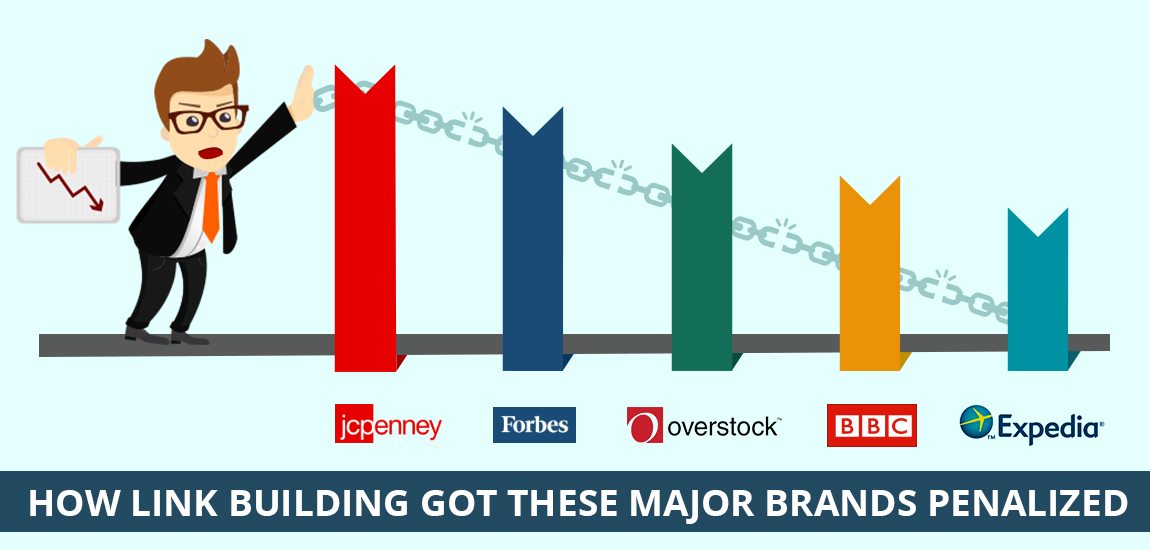
How Link Building Got These Major Brands Penalized – Part 1
In our 2015 Google Algo Update infographic, we referred to 2011 to 2013 as “the penalty years,” when Google handed out penalties right, left and center. That stretched out into early 2014 too, when Matt Cutts announced the death of guest blogging.
Here, we’ll look into how, during this period, some big names fell foul of G’s guidelines in their efforts to accumulate those ever-elusive links for SEO, whether using an in-house marketing teams or an agency. Many of these made news at the time, but have since faded away from collective SEO memory.
However, for digital marketers and link builders, it’s necessary to learn from the mistakes of others, know what worked in the past but doesn’t anymore and vice versa, and identify loopholes in Google’s algorithm – the proverbial chinks in their armor – that they aren’t able to successfully close (and have to resort to manual penalties as a result). Hence this refresher.
The sites we talk about here tick off two attributes:
- They’re big brands.
- Google manually penalized them for their link building methods.
Let’s dive in.
J. C. Penney
This was one of the first casualties of Google’s intensified link spam-fighting efforts, starting in early 2011. The New York Times broke the story at a time when the mainstream business and tech media were still green about SEO, as you can see from what PCMag wrote:

What they did
J. C. Penney’s SEO agency SearchDex employed pretty much every spam linking technique, including paid links, exact match anchors, doorway pages, footer links, Web 2.0 spam, and sitewide links to get them the #1 spot for hundreds of head and long-tail terms like bedding, baby cribs, and samsonite carry on luggage.
What happened next
JCP’s keyword rankings dropped roughly 70 spots. They denied all knowledge of SearchDex’s activities.
Webmasters woke up to the perils of link spam. Panda followed a few days later. Google and Matt Cutts did a lot of explaining on the nature of penalties.
How they recovered
JCP worked to remove all the spammy links and sites they had built. They also restructured their URLs. Google lifted the penalty after 90 days and JCP got most of their visibility back.
Further reading
- https://www.nytimes.com/2011/02/13/business/13search.html
- https://www.dougunplugged.com/2011/jcpenney-black-hat-seo-analysis/
- https://in.pcmag.com/internet/28380/news/jc-penney-fires-back-at-google-and-new-york-times
- https://searchengineland.com/90-days-later-google-lets-j-c-penney-out-of-timeout-78223
Forbes
This is the view from the other side. In 2011, Forbes got penalized for selling links. This wasn’t the earliest instance of a major online publisher linking out not totally editorially, so to speak. In 2007, several big name publishers – including Washington Post and Engadget, as well as key SEO blogs such as Search Engine Journal, Copyblogger and Search Engine Roundtable – found their PageRank demoted for selling links. However, this wasn’t an action targeted at a single site.
What they did
Forbes had been riding the Google economy and blatantly linking out for quite some time, along with others of their creed. Here’s an example footer from a page they took down later:
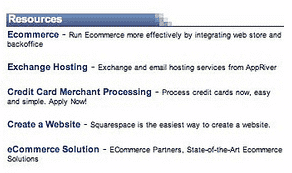
These are links with exact match anchor text inserted through a major link network/exchange (at that time) called LinkExperts (now Conductor).
What happened next
Forbes tried to act dumb and their Digital Marketing Manager posted a copy of the manual penalty message that they received on the Google Webmaster Central Support Forum.

How they recovered
Forbes probably submitted a reconsideration request after they cleaned up the links. They also restructured their site. Their Chief Product Officer published an apology.
Further reading
- https://productforums.google.com/forum/?hl=en#!category-topic/webmasters/crawling-indexing–ranking/TkYkXal4CLM
- https://www.seroundtable.com/forbes-google-penalty-12967.html
- https://techcrunch.com/2011/02/16/forbes-accused-of-link-spam-plays-dumb-but-forgets-to-delete-all-the-links/
- https://www.businessinsider.com/companies/linkexperts
- https://www.forbes.com/sites/lewisdvorkin/2011/02/17/the-pains-of-rebuilding/
Overstock
The Overstock penalty followed close on the heels of JCP and Forbes. And yet they got slammed for a totally different kind of penalty – unnaturally building a specific kind of links.
What they did
Overstock overdid the old school SEO “trick” of getting links from .edu domains (which were initially considered more “trustworthy” than their .com counterparts).
For those who came in late, university websites used to have a page that listed a bunch of companies that gave discounts to their students and staff. Overstock – like a gazillion other companies – offered a 10% discount to these universities so that they could be listed on that page and get a link in return. They also got students and faculty to blog about them using exact match anchor text.
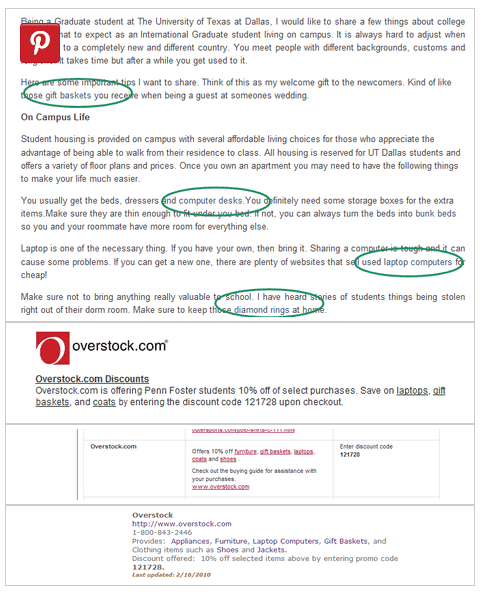
Poor as this strategy is, it used to work. Overstock ranked in the top 5 for nearly all of the terms they competed on.
What happened next
Someone (probably a competitor) started discussing this on the WebmasterWorld forum, Google got wind of it and took action. Overstock.com dropped about 60 places on the SERPs. WSJ reported it and SEOs had were all over the JCP-Forbes-Overstock debacle. And you thought Google’s FUD tactics are new?
How they recovered
The task was simple enough. Overstock had all their .edu links removed. They were back in the SERPs after two months and circulated a press release declaring so. The misadventure cost them a 5% decline in sales.
Further reading
- https://www.webmasterworld.com/google/4252178.htm
- https://www.wsj.com/articles/SB10001424052748704520504576162753779521700
BBC
Sometime in 2013, the BBC got a “notice of detected unnatural links” out of the blue. It is unthinkable that the BBC, with over 2 billion links at the time, needed to engage in linkbuilding.
What they did
Taking a leaf out of Forbes’ book, Nick, a BBC representative, asked for help on Google’s Webmaster Central Forum.

What happened next
It didn’t appear BBC had lost any traffic or rankings. There was speculation that RSS scrapers were abusing the BBC’s feed and unwittingly giving them thousands of links per post.
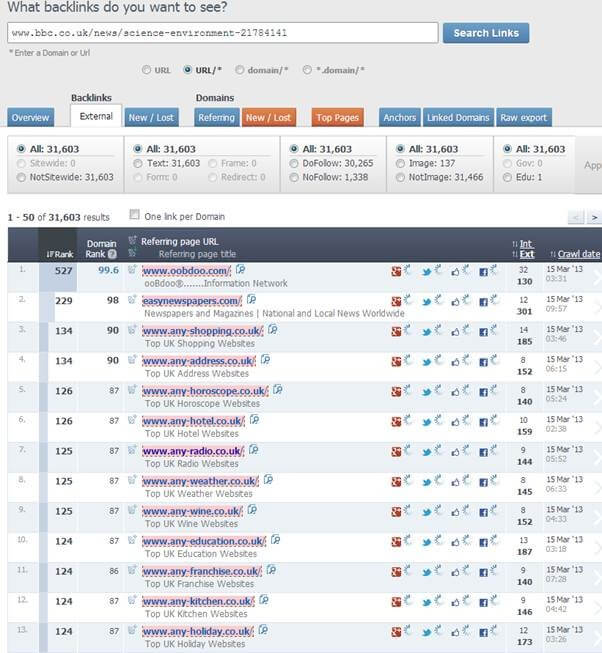
However, John Mueller responded that Google had found unnatural links to an individual article and taken “granular” action on that basis. He confirmed that the rest of the site wasn’t affected.
How they recovered
Google probably let it go. That leads one to ask, what was the point, other than muscle-flexing?
Further reading
- https://productforums.google.com/forum/#!category-topic/webmasters/XNBqi7n-UEk
- https://www.seroundtable.com/bbc-google-link-penalty-16505.html
- https://www.davidnaylor.co.uk/rss-the-seos-worst-nightmare.html
Expedia
Online travel behemoth Expedia got hit in January 2014 for violating probably every linking guideline that Google ever put out, a la JCP. They lost 25% of their visibility on Google.com.
What they did
Expedia had clearly paid for links, with anchor text variations of keywords such as flights, hotels, car rentals and vacations, from all over the place – directory and article submissions, press releases, microsites, WordPress themes, link lists, and especially the then flavor of the season, guest posts from low quality blogs.
What happened next
Giant killer Nenad Simicevic outed them in a blog post. The SEO industry got talking on YCombinator and Google apparently wised up. Expedia’s SERP visibility dropped like Galileo’s balls.
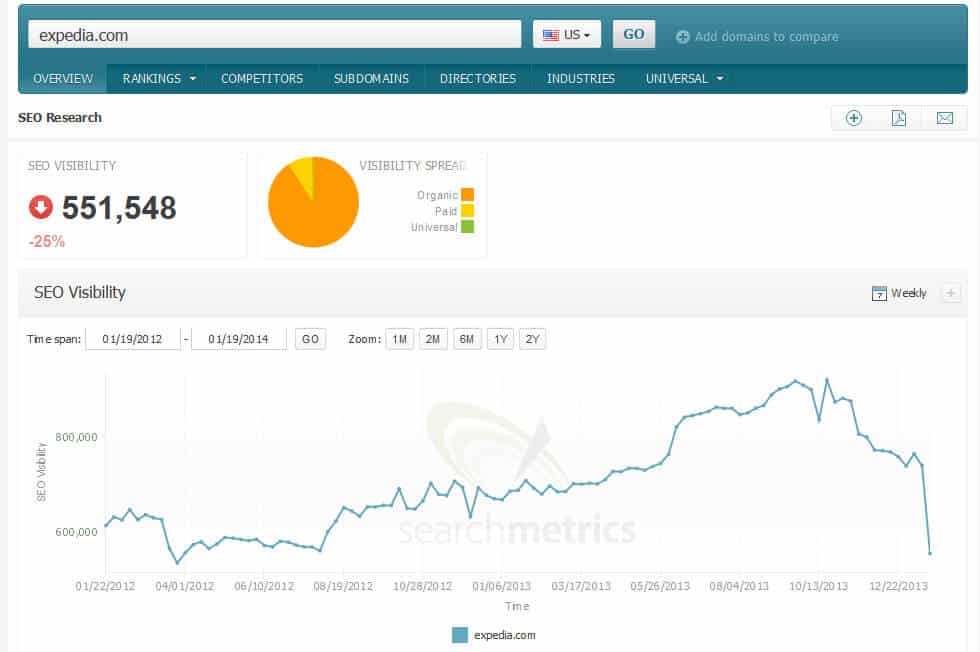
Outgoing Inbound Marketing Director Martin Macdonald categorically denied any involvement in the link building program. Their official PR agency declined to comment. So did Google.
How they recovered
Of course they cleaned up all their spammy backlinks, but since neither Expedia nor Google confirmed the penalty, we will never know how much of their visibility and traffic they got back. I’ll reiterate here that all the domain authority and visibility you lose after a manual or algorithmic penalty for unnatural links is never regained just by wiping your existing-link-profile-slate clean.
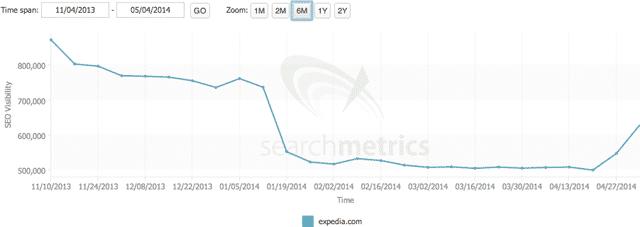
Further reading
- https://nenadseo.com/new-seo/
- https://news.ycombinator.com/item?id=6976818
- https://www.linkresearchtools.com/case-studies/expedia-google-unnatural-link-penalty/
- https://blog.searchmetrics.com/us/2014/01/22/seo-analysis-why-expedia-com-lost-25-of-their-visibility/
- https://www.seroundtable.com/expedia-traffic-returns-18522.html
- https://www.tnooz.com/article/market-punishes-expedia-report-google-link-penalty/
Watch This Space
Hope you read up all the resources I pointed to and had fun digging through each case. The more practical examples of outing, penalization, reporting, analysis and recovery that you look at, the stronger your intuition gets as you build links for your own sites.
In another part, we’ll investigate how Google arm-twisted Mozilla, Halifax, and a few other brands into compliance. Stay tuned.







Hi Rohan,
Great post, helped to learn many new things.
Thanks for the share.
Nice post but I think link building is beneficial if it is genuine and it should be earned link not paid.. we should Build a genuine, engaged community which interacts with your website and each other.